pp.1-5
Abhishek Dixit1, Mukesh Agarwal2
1 Assistant Professor, Department of Computer Science & Engineering, JECRC, Jaipur, India 2
Associate Professor, Department of Computer Science & Engineering, JECRC, Jaipur, India
Abstract: This paper shows some important techniques of Search Engine Optimization (SEO). This paper covers the history of SEO, White Hat SEO, Black Hat SEO, on page SEO, Off Page SEO, their benefits, summary and conclusion. This paper illustrates about Google Analytics and Google Webmaster tools which are provided by Google Inc. to enhance functionalities of web applications. This paper demonstrates the work on the website and tells how to achieve better search engine rankings. The comparison between the data in the interval of three months shows the result and conclusion.
Keywords: On page SEO, Off page SEO, Google Analytics, Google Webmaster, Google Panda, Google Penguin.
INTRODUCTION
Search Engine Optimization (SEO) is the activity of optimizing web pages or whole sites in order to make them search engine friendly, thus getting higher positions in search results. Internet is growing at a rapid pace and it has huge impact on several businesses. Several companies run their business online and websites have become integral part of the business. Besides this, many companies focus on providing online services to their customers. It has become very significant for the companies to track the web information of their websites. This information will help to predict the behavior of the customers or viewers towards the website. Such information will also help to track the likes/dislikes of the viewers. Web Analytics tool like Google Analytics will collect large information such as browser type, location, device type, screen size etc. Further analysis of such data will be helpful to make websites more efficient and more useful to the customers.
The companies that tend to provide services online need to hold a good rank in various search engines such as google, yahoo, Bing etc. Every company wants their website to appear in the top results of the relevant search queries. And for this they employ different SEO tactics [1]. Google Webmaster is one such tool provided by Google Inc. through which companies can make their websites easily recognizable by Google. Google Webmaster will enable its
user to submit the details about his/her website so that Google Search will index it and will reflect during the search queries. Google Webmaster will enable a company to tell the details about their websites to the Google.
SEO GOALS
The goal of SEO is to help websites or web pages to achieve top placement in the organic search results by increasing the relevancy of a website or web page to the search query that users type on the search engine. Displaying the most relevant pages for the search query has many benefits to both the user and the search engine providing the results: the user finds the most relevant results for the keyword used, and the search engine is perceived as reliable and trustworthy because its algorithm displays the most relevant pages. Since SEO is concerned with improving a site’s rankings on the organic or natural search results, the process requires time and knowledge of tactics to implement. Time is a huge initial investment to be made to the website or page being optimized, and an ongoing maintenance to maintain the site’s top rankings. Depending on how competitive the target keyword is (or group of keywords) that will be used for optimization, SEO may take weeks or even months before seeing any results. Although the results of the SEO may not be seen immediate,
the long-term benefits of SEO can mean top rankings and a high volume of user visiting the site.
CATEGORIES OF SEO TECHNIQUES
White Hat SEO: White Hat SEO techniques follow some rules, regulations and guidelines suggested by the search engines. It is also called ethical because it follows certain legal guidelines and policies to achieve high ranking. Some most popular techniques used by White Hat SEO include Quality Content, using structural markup and separate content from presentation, titles and meta tags, Quality inbound links, effective keyword use and keyword research. White Hat SEO is more frequently used by those who intend to make a long-term investment on their website. Black Hat SEO[5]: Black Hat SEO techniques, as opposite to White Hat SEO technique are unethical way of handling the search engine’s algorithm. These techniques are not suggested as there is a very great risk of website getting removed from the search engine’s database index. So, there is a chance of banning the website by the search engine. Black Hat SEO techniques includes hidden content, Meta keyword stuffing, Doorway or gateway pages or link framing. It has been seen that large percentage of users uses search engine and it has been increasing day by day. In fig-1 it is clear that the no. of users using search engine has been increased from 85% to 92%. In recent years social networking sites are increasing their presence on the internet world at a great speed. In year 2002 only 11% users were using social networking websites which has now increased to 66% in the year 2012.
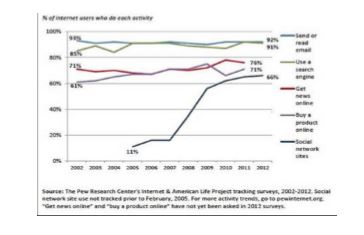
Fig-1 % of internet users who do each activity [7]
IV. TERMS USED IN SEO A. Ranking: The position of the webpage within the search engine results pages.
B. Organic search results: Results that are generated directly from the search engine’s ranking algorithm based on search query relevancy and these results are free from commercial payments.
C. Paid listings: These are also known as sponsored listings, inorganic results or advertisements that appear adjacent or above the organic search results. These are paid advertisings that are displayed whenever a searcher’s keyword matches with the advertiser’s keyword list”.
D. PageRank: It is the ranking algorithm used by Google Search that assigns a numerical weighting to each element of a hyperlinked set of documents, such as the World Wide Web for ‘measuring’ its relative importance within the set.
E. Pay-per-click (PPC): Each time a user clicks on any of the paid listings, the advertiser pays a certain amount for each click.
F. Google Adwords: Google’s main online advertising platform. It is Google’s main source of revenue. Whoever wants to advertise on Google, can create their ads and choose the keywords that are related to their business.
G. Google AdSense: A free service for publishers, or website owners, which allows them to earn money by displaying Google ads on their site. Website owners have to ability to choose which ads to display and in what format to display them.
H. Web crawler / bot: A program that is “mainly used to create a copy of all the visited pages for later processing by a search engine that will index the downloaded pages to provide fast searches” for users searching for information online.
I. Indexed pages: Search engine crawlers collect, parse and store web page data in the index database for use by the search engine to display on the search results. Once a web page data gets stored in the search engine index, the page has been indexed.
J. Keyphrase / Keyword / Search query: These terms are used interchangeably; it is the word or set of words that a web user enters into the search engine text box for searching.
K. Inbound links / Backlinks / External links: These terms are used interchangeably; these are links from other sites that point to the target website.
RANKING FACTORS
1. On-Page Ranking Factors [4]: Many on-page ranking factors are related to the use of keywords. Keywords in the <title> Tag: Search engines tend to use the <title> tag text as search results titles. All pages must have distinctive page titles.
Keywords in the Page URL: Keywords in a page URL are useful not just for SEO but also for newer CMSs, blog sites, and news sites which allow for URL rewriting techniques to make their URLs stand out by using keywords in the URLs. The keywords referred to the base domain name. Keywords in the Page Copy: When we talk about keywords in the page copy, it means the number of times a particular keyword or keywords occur in the body of a document. Before optimizing keywords, do the necessary investigation and figure out what people are searching for in the particular topic. Keywords in the <meta> Description Tag: The text in the <meta> description tag is not seen on the page itself, but is often displayed in search results. Keywords in the Heading Tags: Webmasters have used multiple H1 tags in the belief that search engines give those tags priority. Keyword Proximity: Keyword proximity refers to how close two or more keywords are to each other in page copy. Whenever possible, important keywords should not be broken. Keyword Prominence: Keyword prominence refers to relative keyword positions with respect to the start of the HTML page. The keyword prominence factor increases in importance as the document size increases. If the page is very large, ensure that your most important keywords are close to the beginning of the page. Keywords in the Link Anchor Text: The link anchor text is all about keyword relevance. In general, all links should contain relevant keywords in the link anchor text. Quality Outbound Links and using keyword in outbound links: Staying on focus is the underlying idea behind having quality outbound links. It is about what web visitors want? Size or Quantity of Content: When we talk about content size, it means the quantity of indexed documents on a
particular site. Therefore, content size applies not only to our sites, but also to our competitors’ sites. Freshness of Pages: Depending on the site, the ratio of new to old pages could play a role in how search engines rank our site.
2. Off-Page Ranking Factors / External Ranking Factor[8]: External Links: External links are also known as backlinks, inbound links, and referral links. As our website gains popularity and fame, managing external inbound links will become a necessity. It is important to know who is linking to our site, especially if you are in an industry where reputation is paramount. To see who is linking to our site, we can use Google’s link: command: link: ourdomain.com Quantity and Quality of External Links: Getting more and more external inbound links is something that everyone wishes. If these links can be quality links with a lot of link juice, that’s even better. It has been suggested to acquire inbound links from sites or pages with high PageRank values. As a rule of thumb, backlinks with a minimum PageRank value of 5 yield the best results. Speed of backlink accumulation: If all your backlinks are using the same anchor text, search engines may view this as suspicious activity, which might trigger a manual inspection by the search engines and a delisting of your site. Backlinks from directories: Be careful while choosing the directory for a website, as not all are created equal. Checking the PageRank of each directory is suggested to determine whether it is worth having your listing there. Age of backlinks: A new backlink on a page that is constantly changing is not as beneficial as an old backlink on the same page. Broken Outbound Links: Although site updates and migrations are part of your website life cycle, broken links can be a significant cause of lost visitors, especially if our site is not being updated on a regular basis. User Behavior Patterns: Although user behavior patterns can be a great help to search engines, they do come at a price: privacy. Everything you do can be used by search engines in user behavior analysis. For instance, Google is pushing the envelope to such an extent that it claims it can provide personalized search results. Analyzing the Search Engine Query Interface: In this section, we will take on the role of a search engine and examine what we can learn about behavior patterns.
Google Analytics [2]: Although the Analytics platform certainly provides many helpful tools, some webmasters choose to stay away from it due to data privacy concerns. Google Toolbar: Google has acknowledged that when the advanced toolbar features are turned on, every visit to every page is sent to Google, which then sends the PageRank value back to the toolbar.
INSTALLATION AND SETUP GOOGLE ANALYTICS
Google Analytics feeds off a small piece of JavaScript code that we need to place in every page that requires tracking. Before we can use Google Analytics, we must register for a Google account. We can sign up for an account by visiting http://www.google .com/analytics/. The account signup process is relatively painless and takes about two minutes to complete. There are four screens in total. On the last screen, Google provides you with the JavaScript code you can place in your web pages. The code looks similar to the following fragment [8]: <script type=”text/javascript”> var gaJsHost = ((“https:” == document.location.protocol) ? “https://ssl.” : “http://www.”); document.write(unescape(“%3Cscript src='” + gaJsHost + “google-analytics.com/ga.js’ type=’text/javascript ‘%3E%3C/script%3E”)); </script> <script type=”text/javascript”> try {var pageTracker = _gat._getTracker(“UA-989985l-l”); pageTracker._trackPageview(); } catch(err) {} </script> Instead of placing this code into every single HTML file, factor it out into an external file that is called by your site template file.
ANALYSIS
Traditional Mechanisms for the analysis were to build separate tools which could record the impressions on the basis of IP address and further more details are carved. Traditional SEO tactics were to make websites promotional through links. The latest techniques for such concepts are provided by Google that are Google Analytics and Google Webmaster. These mechanisms are very important for making websites more operational and useful. To make the analytic environment more specific and more accurate it is integrated with the website backend interfaces such as Administration Panel. The choice depends on the level of features which are to be accomplished for such tasks. The website used for the operational purpose is www.rtupaper.com.
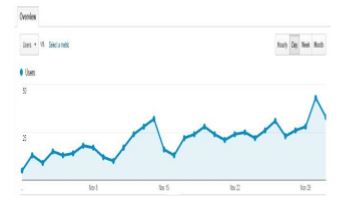
Fig-2 No. of users on the website in month of November 2014
In the above google analytics image, it has been observed that by using the selective approach numbers of users are increasing day by day in the month of November 2014.
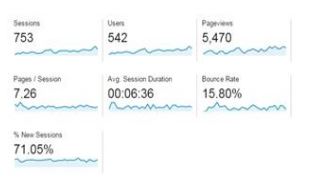
Fig-3a No. of sessions in the website in month of November 2014
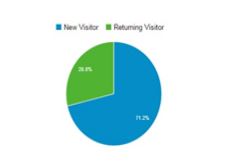
Fig-3b Users % on the website in month of November 2014
The above graphs were plotted from google analytics of the website www.rtupaper.com in the month of November 2014. Which shows that there were only 753 sessions and 542 users with page views of 5470 and the % of new sessions were 71. Percentage of returning visitors were 29%.
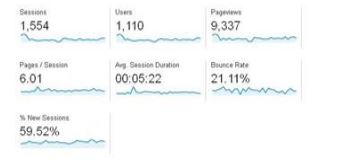
Fig-4a No. of sessions in the website in month of February 2015
The above graphs were plotted from google analytics of the website www.rtupaper.com in the month of February 2015. Which shows that there are 1554 sessions and 1110 users with page views of 9337 and the % of new sessions were 60. Percentage of returning visitors were 40%.
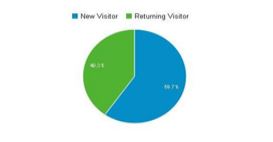
Fig-4b Users % on the website in month of February 2015
It has been clear that by using selective hybrid approach the number of users increased rapidly in the period of 3 months.
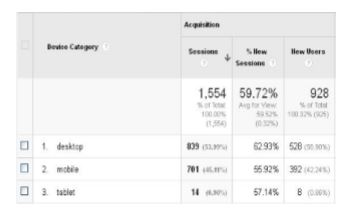
Fig-5 Comparison of sources of users coming on www.rtupaper.com
The Google analytics images also shown that almost equal no. of users are coming from desktop as well as mobiles. There are very few users who are coming from tablet device. The above information can be a very useful for designers of the website and manufacturers of the hardware
units. There is an immense opportunity for the designers to come up with a new mobile app for the same.
CONCLUSION In this paper we have proposed efficient methods of integrating Google Analytics and use Web Master to improve in terms of Search Engine Optimization. The proposed mechanism is integrated with an online website to gather the required data and analyze it on practical basis. Consequently, it will be beneficial to use these tools easily and develop new methodology that would improve the existence and use of websites.
FUTURE SCOPE These tools are very much efficient in terms of management of websites. Further integration of such tools and developing new methods to utilize these tools will help the companies to elaborate their online business and to hold a good position in the search results of various search engines.
REFERENCES
[1] Neshat, Hamed Sadeghi: Ranking of New Sponsored Online Ads. (IEEE), 2011.
[2] http://trends.builtwith.com/analytics/Google-Analytics
[3] http://support.google.com/googleanalytics/bin/answer.py?hl=en&ans wer=99118
[4] Su, et al: How to Improve Your Google Ranking: Myths and Reality. (IEEE), 2010.
[5] http://en.wikipedia.org/wiki/Content management system
[6] http:// www.google.com / webmasters / docs / search – engine optimization – starter – guide.pdf
[7] Edgar Damian Ochoa, May 2012, An Analysis of the application of selected search engine optimization techniques and their effectiveness on google search ranking algorithms
[8] Jhon I. Jerkovic Title: Essential techniques for increasing web visibility: SEO Warrier, Publication O’Reilly
